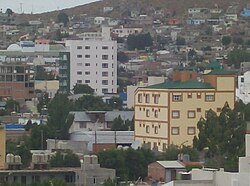
Back كاليتا أوليفيا Arabic كاليتا اوليفيا ARZ کالتا اولیویا AZB Caleta Olivia CEB Caleta Olivia Czech Caleta Olivia Welsh Caleta Olivia German Caleta Olivia Esperanto Caleta Olivia Spanish Caleta Olivia Basque
Caleta Olivia | |
|---|---|
 | |
| Coordinates: 46°26′S 67°32′W / 46.433°S 67.533°W | |
| Country | |
| Province | |
| Department | Deseado |
| Founded | November 20, 1901 |
| Founded by | Exequiel Guttero |
| Government | |
| • Intendente | Fernando Cotillo |
| Area | |
• Total | 55 km2 (21 sq mi) |
| Elevation | 13 m (43 ft) |
| Population (2010 census) | |
• Total | 51,733 |
| • Density | 940/km2 (2,400/sq mi) |
| Time zone | UTC−3 (ART) |
| CPA base | Z9011 |
| Dialing code | +54 297 |
| Climate | BSk |
| Website | Official website |
Caleta Olivia is a city located at the northeast of the Argentine province of Santa Cruz, on the San Jorge Gulf by the Atlantic Ocean. It had a population of 70,304 in the 2010 census [INDEC]. It is the second most important city of the province after Rio Gallegos, and the most populated of the Deseado Department.
The city was founded on November 20, 1901, by Navy Lieutenant Exequiel Guttero, captain of the Guardia Nacional, a ship that was transporting cables, equipment, and workers for the construction of a telegraph line south of Comodoro Rivadavia. The settlement was given the name of his wife Olivia (caleta means "small bay", "inlet").

The main economic activities around the city are petroleum, sheep and fishing. Its port serves both as a fishing centre, and as an export point for locally produced goods.
Among the monuments of the city, probably the most characteristic is that of "El Gorosito," built to honour a petroleum industry worker.

